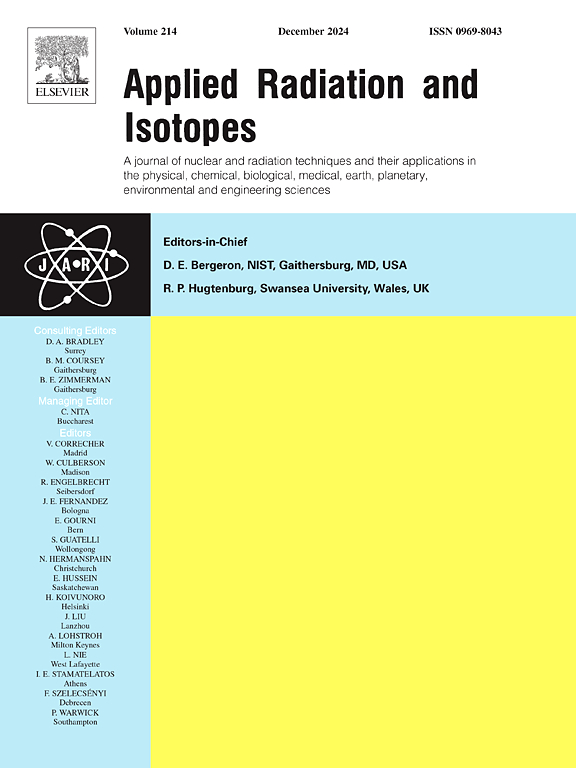An approach to measure low LET radiation at high dose using CR-39 track detector
IF 1.6
3区 工程技术
Q3 CHEMISTRY, INORGANIC & NUCLEAR
引用次数: 0
Abstract
CR-39 track detectors are commonly used for measuring high LET (linear energy transfer) radiation with LET values above 10 keV/μm. This study proposes a method for using CR-39 to measure low LET radiation, such as photons and electrons, at high doses in the order of kilogray (kGy). CR-39 detectors were irradiated with bremsstrahlung photons generated from 10 MeV electrons striking a tantalum target, resulting in absorbed doses ranging from 6.5 kGy to 261.4 kGy. FLUKA Monte Carlo simulation was performed to estimate the dose deposition in CR-39 due to bremsstrahlung photons and to estimate the primary and secondary electron fluences incident on CR-39. The simulations revealed that the secondary electrons produced by the interactions of primary electron beam were of two orders less magnitude than that of bremsstrahlung photons. The results showed no significant changes in the absorbance values of different functional group vibrations of unetched CR-39 even they were exposed to high dose up to 261.4 kGy. However, after chemical etching, the intensities of two prominent peaks at 1230 cm−1 (aliphatic ester C–O–C stretching) and 1735 cm−1 (ester C=O stretching) significantly decreased at doses above 65.3 kGy. The study demonstrates the feasibility of using CR-39 track detectors for measuring low LET radiation at high doses in the range from 46 to 197 kGy by combining FTIR spectroscopy with chemical etching.
用CR-39径迹探测器测量高剂量低LET辐射的方法
CR-39轨道探测器通常用于测量LET值大于10 keV/μm的高LET(线性能量传递)辐射。本研究提出了一种利用CR-39测量低LET辐射(如光子和电子)在高剂量下(kGy)的方法。用10 MeV电子撞击钽靶产生的轫致辐射光子照射CR-39探测器,吸收剂量在6.5 ~ 261.4 kGy之间。采用FLUKA蒙特卡罗模拟方法估计了轫致光子在CR-39中的剂量沉积,并估计了入射到CR-39上的一次和二次电子影响。模拟结果表明,由初级电子束相互作用产生的次级电子比轫致辐射光子的量级小两个数量级。结果表明,即使在高达261.4 kGy的高剂量下,未蚀刻CR-39对不同官能团振动的吸光度值也没有显著变化。然而,在化学蚀刻后,当剂量高于65.3 kGy时,1230 cm−1(脂肪酯C - O - C拉伸)和1735 cm−1(酯C=O拉伸)两个显著峰的强度显著降低。本研究通过FTIR光谱与化学蚀刻相结合的方法,证明了利用CR-39径迹探测器测量46 ~ 197 kGy高剂量低LET辐射的可行性。
本文章由计算机程序翻译,如有差异,请以英文原文为准。
求助全文
约1分钟内获得全文
求助全文
来源期刊

Applied Radiation and Isotopes
工程技术-核科学技术
CiteScore
3.00
自引率
12.50%
发文量
406
审稿时长
13.5 months
期刊介绍:
Applied Radiation and Isotopes provides a high quality medium for the publication of substantial, original and scientific and technological papers on the development and peaceful application of nuclear, radiation and radionuclide techniques in chemistry, physics, biochemistry, biology, medicine, security, engineering and in the earth, planetary and environmental sciences, all including dosimetry. Nuclear techniques are defined in the broadest sense and both experimental and theoretical papers are welcome. They include the development and use of α- and β-particles, X-rays and γ-rays, neutrons and other nuclear particles and radiations from all sources, including radionuclides, synchrotron sources, cyclotrons and reactors and from the natural environment.
The journal aims to publish papers with significance to an international audience, containing substantial novelty and scientific impact. The Editors reserve the rights to reject, with or without external review, papers that do not meet these criteria.
Papers dealing with radiation processing, i.e., where radiation is used to bring about a biological, chemical or physical change in a material, should be directed to our sister journal Radiation Physics and Chemistry.
 求助内容:
求助内容: 应助结果提醒方式:
应助结果提醒方式:


